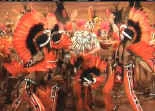Irving Berlin's brilliant musical gem is polished and preserved on this Warner DVD release. Annie Get Your Gun is an explosion of music, song, dance and color. Not seen on TV or theatrical release since 1973 owing to rights questions, movie lovers are in for a special treat.
Annie Get Your Gun is holstered in a good story. The competition and romance between sharpshooters Annie and Frank Butler in the arena of Buffalo Bill's Wild West Show is a charming framework for Berlin's wonderful tunes. The wild Annie's first meeting with Butler and the ensuing contest sets the stage for these two characters with obvious joy. The ensuing rise of Annie in the show, the budding romance, the split and the reunion, is all told in exquisite musical terms.Annie Get Your Gun boasts a full load of musical ammunition with songs like There's No Business Like Show Business, Doin' What Comes Natur'lly, The Girl That I Marry, You Can't Get a Man with a Gun, My Defenses are Down, Anything You Can Do, and I Got the Sun in the Morning. They are uniformly terrific.
Judy in pastel. ©Warner
Betty in acrylic. ©Warner
Betty Hutton fires away with her branded comic gusto. Hutton's broad portrayal of Annie Oakley is more like a barrage of buckshot than a single penetrating bullet. Every Annie emotion is bandied about in beautiful Technicolor. Hutton was a great choice to fill in for Judy Garland after the studio let her go during this fabled troubled production. Their styles are blatantly different and while you can see what you were missing by not having Garland play Annie, Hutton's manic effervescence is a great asset to most scenes. Howard Keel, MGM's great musical leading man, makes his starring debut as Frank Butler. Keel is a towering presence, physically and musically and can act to boot.. With his sonorous baritone voice, Keel puts over every song in the Annie Get Your Gunarsenal with dead eye acumen. Keenan Wynn brings a strident energy to show manager Charlie Davenport, Louis Calhern is a dignified Buffalo Bill, and J. Carroll Naish stone faced as Chief Sitting Bull. (Incredibly, Naish reprised his role in the 1954 Sitting Bull.)
Charles Rosher was ®Oscar nominated for the color photography, but it is worth a sidebar that Harry Stradling was behind the camera for the Judy Garland/Busby Berkeley scenes. The visual difference in the "I'm a Indian Too" (Included on the outtakes.) number is dramatic. Instead of the happy, bright, colors of Rosher, Stradling gives paints with a surreal palette, skies awash in a warm water color mural of orange, yellow and purple. Even the Indians costumes blend with the back drop and Garland trussed in charming buckskin green stands out, like a young girl playing in before the mirror of her imagination. Perhaps a different set designer was involved under Berkeley's direction as well.
George Sidney does a fine job of putting setting the two major montages to music with quick snippets of the merry-go whirlwind of Annie Oakley's life with the big show. Somewhere behind the scenes, maybe even over the rainbow, the tasteful influence of MGM master musical producer is looking over the production. The screenplay by Sidney Sheldon moves like a Gatling gun and the scoring by Adolph Deutsch and Roger Edens keeps apace.
The Technicolor is a as spectacular as the staging and music. Brilliant saturation highlights every scene. There are a few minor registration errors, but the transfer seems to doing some magic all its own. The color pulsing, so endemic to many older three strip films, is also lassoed in on this transfer. Every once in a while I thought I saw a trace of it, but something masked it beautifully. Sharpshooters will admire Annie Get Your Gun for its resolution of detail. Contrast is consistently eye popping. Betty Hutton literally has to be contained from jumping onto your lap in the home theater. But the blaze of rich color is the unparalleled prize in this shootin' match. The mono sound is fine and dialogue and songs cleanly delivered. There was one moment when something Davenport said reverberated, but it was likely my surround processor playing tricks on me.
The special edition includes outtakes of the two completed numbers starring Judy Garland, the aforementioned "Indian" and "Doin' What Comes Natur'lly." (These were on laser disc inThat's Entertainment Part III.) There is an especially poignant moment glimpsed at the end her number when the call of "Action" interrupts her dialogue: Judy stares ahead with a drugged look in her eyes, sullenly pouting "Hey, you cut before I got my lines...." Is this the same Judy that just delivered a musical performance filled with energy and charm? The original opening number Colonel Buffalo Bill directed by Berkeley is also included with a brief shot of Frank Morgan as Buffalo Bill. Morgan died during the early stages of production and Calhern replaced him. The remaining out-take is the lovely production number, Let's Go West Again, sung by Hutton, shot at the behest of Irving Berlin, but eliminated from the final cut for reasons of pacing. There's a theatrical trailer and a short introduction by television soap Queen Susan Lucci, breezing through the production history of the show.

